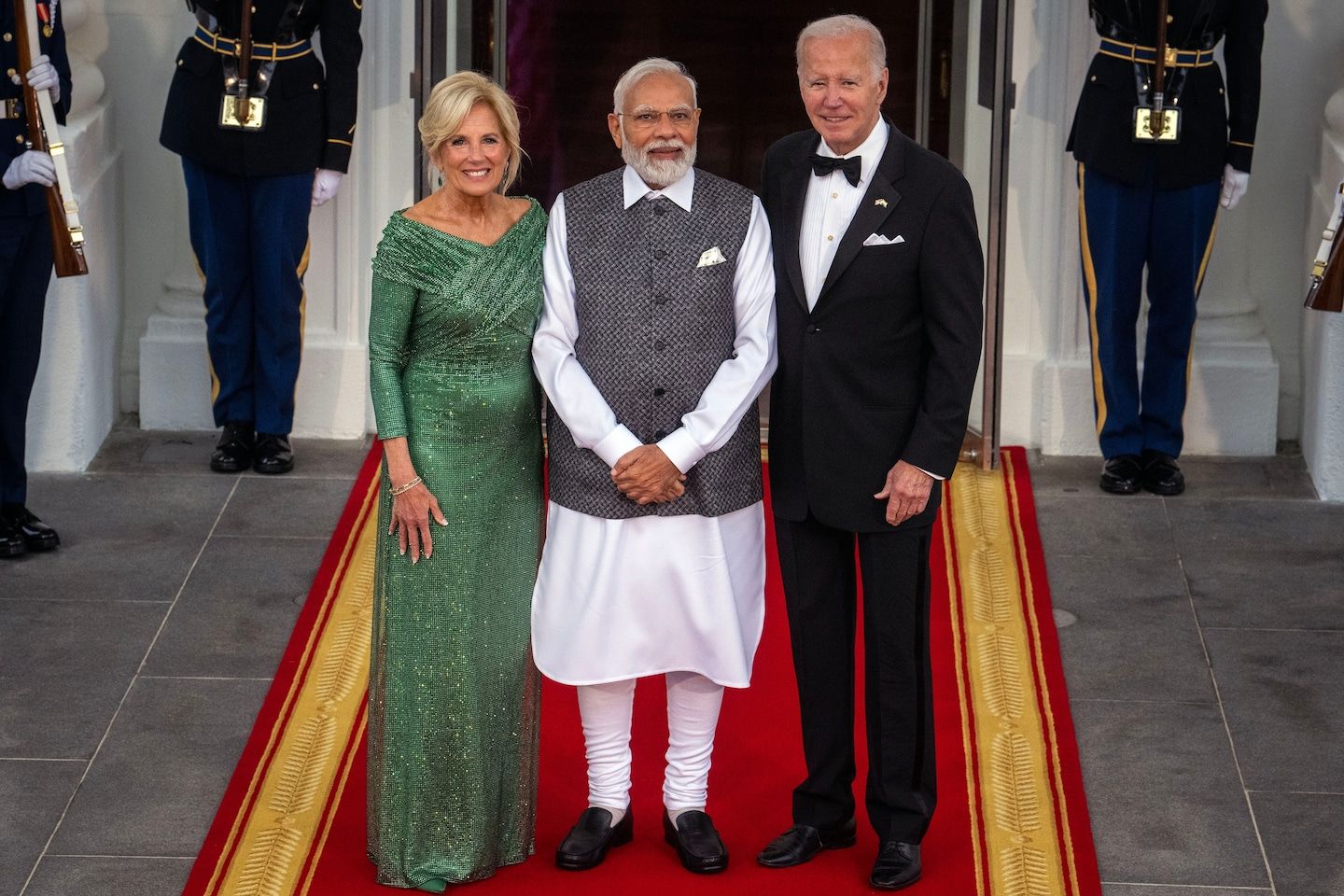State dinner for India becomes an unlikely celebration of fashion
Listen 4 min Share this article Share Comment on this story Comment
The Biden administration made a friendly overture to the world of fashion at Thursday’s state dinner with Indian Prime Minister Narendra Modi. In addition to the usual mix of congresspeople, entertainers and Biden family members, a clutch of high-profile fashion figures attended: designer Ralph Lauren, who practically wrote the manual on American style; the Lebanon-born, New York-based Reem Acra; and Dior creative director Maria Grazia Chiuri, accompanied by Indian entrepreneur Karishma Swali, who runs the Mumbai embroidery atelier Chanakya.
Billie Jean King, Tim Cook and M. Night Shyamalan were among the attendees of President Biden’s state dinner for Indian Prime Minister Narendra Modi on June 22. (Video: The Washington Post)
Each of the designer guests had clear connections to the evening’s proceedings. Lauren designed the green sequined wrap dress first lady Jill Biden wore on Thursday evening, along with granddaughter Naomi Biden’s wedding dress for her White House nuptials last November. Acra is a favorite designer of the first lady. And Chiuri has spent the past two years of her seven-year tenure at Dior emphasizing the role of India in global craftsmanship. Chanakya, which is Swali’s family business, has long provided embroidery work to some of the most significant luxury fashion houses, puncturing the myth that sublime fashion technique comes only from Europe. In Paris, where the city’s craftsmanship is practically as protected as champagne grapes, this is a surprisingly controversial position.
This state dinner was low on celebrity wattage, and perhaps the designers were invited to provide some star power. But their presence was also a hint about how the Biden administration, which tends to shy away from conversations about style, might think about fashion more broadly. It’s less about what is worn — by the first lady, by her husband, by her guests — and more about what those clothes and their makers stand for.
Washington is not a fashion-friendly city, per se; asking elected officials what they’re wearing often earns a laugh or an eye roll. There is an established uniform, or at least a dress code with strict parameters, from which few dare to deviate.
Advertisement
Perhaps because the city is motivated by a shared sense of purpose, clothes can seem like foolish talk. But this is a recent development. Why, after all, are both the aesthetic as well as individual styles of the Kennedy administration still such a romanticized touch point, for Democrats and Republicans alike?
The idea that fashion — whether wearing it, enjoying it or just thinking about it — should be a source of shame is a strange and contemporary invention.
The Obamas made it feel cool, even American, to care about what brands from Versace to Jason Wu were creating; Melania Trump, on the other hand, had such a strong devotion to fashion that perhaps the public feels taking any pleasure in appearance can seem garish.
Whether this is the Biden administration building a more formal bridge to the fashion industry is difficult to say. (The White House did not reply to a request for comment.) Designer Gabriela Hearst and Vogue editor in chief Anna Wintour attended the Bidens’ first state dinner, for France in late 2022. And Lauren’s D.C. credentials are more than sartorial. In April, he opened a cancer-research facility in Georgetown (the continuation of a relationship that began in the late 1980s, when Lauren co-founded the Nina Hyde Center for Breast Cancer Research with then-Washington Post publisher Katharine Graham; Hyde was the paper’s former fashion editor).
Lauren and Chiuri’s own fashion choices were notable, if only because they were thrust out of the bubble where sartorial eccentricities are accepted as a sign of genius, and into the fire that is Beltway-style criticism. Lauren wore a double-breasted tuxedo with New Balance sneakers — an outfit that legislators, who have lately adopted a controversial sneaker-bottomed dress shoe, are probably desperate to embrace, though it is likely to require Lauren’s charisma to pull off. And Chiuri, whose hair was no longer its usual white-bleached hue but a light brown, wore an understated, if slightly 1950s, skirt suit of her own design; Swali wore a black gown with a slight silver shimmer under a black blazer.
They looked more businesslike, and more somber, than any of the other guests, who seemed to embrace the guest country’s adoration of color in saffron yellow and hot-pink silks or, in Vice President Harris’s case, a coppery sequined gown. Chiuri and Swali’s presences, and stark appearance, suggest that fashion isn’t simply a tool for communication and play — which is how White House style is usually discussed — but a platform to reevaluate our biases around quality and artisanship.
Share
Source: The Washington Post


